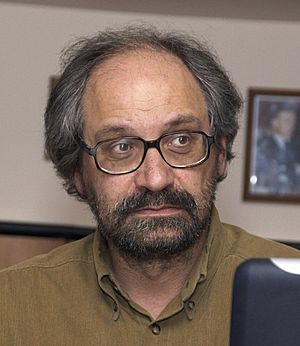Sergei Starostin facts for kids
Quick facts for kids
Sergei Anatolyevich Starostin
|
|
|---|---|

Starostin at the conference in memory of V. M. Illich-Svitych on October 21–23, 2004.
|
|
| Born | March 24, 1953 |
| Died | September 30, 2005 (aged 52) Moscow, Russia
|
| Academic background | |
| Influences | Aharon Dolgopolsky, Vladislav Illich-Svitych, Andrey Zaliznyak, Vladimir Dybo, Sergei Yakhontov |
| Academic work | |
| School or tradition | Moscow school, historical linguistics |
| Main interests | long-range language reconstruction (especially Nostratic and Dené–Caucasian), glottochronology, accentology (especially Indo-European) |
| Notable ideas | Dené–Caucasian hypothesis, reconstruction of Proto-Altaic, Proto-North-Caucasian, Proto-Yeniseian, Proto-Tibeto-Burman, Proto-Kiranti, reconstruction of Old Chinese and Proto-Japanese, advancement of "recalibrated glottochronology" |
| Influenced | Merritt Ruhlen, John Bengtson |
Sergei Anatolyevich Starostin (Russian: Серге́й Анато́льевич Ста́ростин; March 24, 1953 – September 30, 2005) was a Russian linguist. He studied how languages change over time. He was known for trying to rebuild very old, "parent" languages. These are languages that might have existed thousands of years ago.
Starostin worked on several big ideas about language families. He studied the connections between languages like Altaic and Dené–Caucasian. He also suggested an even older language group called Borean. He was also famous for his work on Old Chinese.
Contents
How Languages Are Connected
Sergei Starostin had many ideas about how different languages are related. In 1986, he worked with Igor M. Diakonoff. They suggested that Hurro-Urartian languages are part of the Northeast Caucasian language family. This was an important discovery.
Starostin also helped to reconstruct several ancient languages. He worked on Proto-Kiranti and Proto-Tibeto-Burman. He also studied Proto-Yeniseian and Proto-North-Caucasian. One of his big projects was reconstructing Proto-Altaic. This is a proposed ancient language that might be the ancestor of many languages in Asia.
He also supported the idea that Japanese is an Altaic language. This theory was first suggested a long time ago. It was later brought back by Gustaf John Ramstedt in the early 1900s.
The Dené–Caucasian and Borean Ideas
Starostin developed the Dené–Caucasian hypothesis. This idea suggests that several language families are connected. These include Northwest Caucasian, Northeast Caucasian, Yeniseian, Sino-Tibetan, and Na-Dené. He believed they all came from one single, much older language family.
He went even further with his ideas. Starostin thought that Dené–Caucasian and Austric languages could be linked. He also connected them to the Nostratic family. He called this very early, huge language group the Borean languages. "Borean" means "Northern."
Studying Human Languages
Starting in 1985, Starostin created a special computer program. It was called STARLING. This software helped linguists study languages. He even got help from Murray Gell-Mann, a scientist who won a Nobel Prize.
At the time of his death, Starostin was a professor at the Russian State University for the Humanities. He was also a visiting professor at the Santa Fe Institute. He often gave lectures at Leiden University in the Netherlands. In June 2005, he received an honorary doctorate from Leiden University.
Sergei Starostin passed away on September 30, 2005. He died from a heart attack in Moscow. This happened after he gave a lecture. His son, Georgiy Starostin, also became a linguist.
See also
 In Spanish: Serguéi Stárostin para niños
In Spanish: Serguéi Stárostin para niños

